Where were we? Right. The Aurelian Walls south where the Appia Antica begins. Today it’s known as the Porta San Sebastiano after the Christian soldier martyred by Diocletian whose remains are interred in the basilica that bears his name a couple of miles down the Appia, but its original name when it was built by Aurelian around 275 A.D. was the Porta Appia, for obvious reasons, and the museum’s labels and maps refer to it by the Aurelian name.
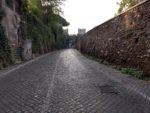 Before you reach the huge gate with its two crenelated towers that make it look like a storybook medieval castle, there’s a much smaller, rather hard-worn Roman arch called the Arch of Drusus. It bears no relation to your friendly neighborhood blogger and probably no relation to any of the other Drusi who have graced (or disgraced) the family name either. It was used as part of an extension of the Aqua Marcia added by Caracalla in the early third century to feed the enormous thirst of his new baths. It pre-existed the construction of the spur, however. All that’s left of it now is a single arch — it used to be a triple — with some concrete and brick on top that likely dates to after the Caracalla-era construction.
Before you reach the huge gate with its two crenelated towers that make it look like a storybook medieval castle, there’s a much smaller, rather hard-worn Roman arch called the Arch of Drusus. It bears no relation to your friendly neighborhood blogger and probably no relation to any of the other Drusi who have graced (or disgraced) the family name either. It was used as part of an extension of the Aqua Marcia added by Caracalla in the early third century to feed the enormous thirst of his new baths. It pre-existed the construction of the spur, however. All that’s left of it now is a single arch — it used to be a triple — with some concrete and brick on top that likely dates to after the Caracalla-era construction.
You can see from the picture that the arch appears as you approach on the Via Sebastiano (closed to traffic on Sundays, btw, so pedestrians and bikes get to spread out nicely). Click to enlarge the image because the arch almost disappears against the towering backdrop of the gate. Here it is as seen from the window of the first gallery in the museum:
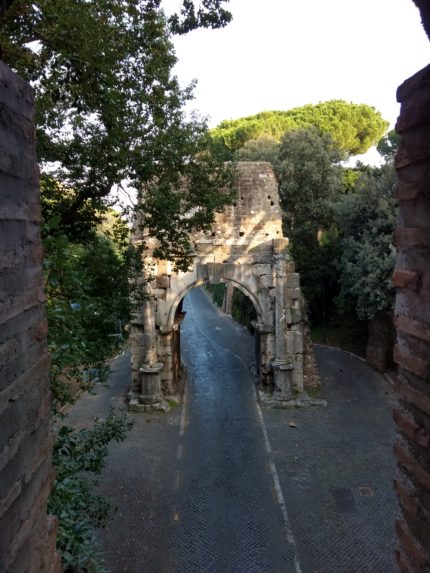
Incidentally, the black and white mosaic inlaid in the marble floor of that first gallery (see pic from yesterday) is not ancient. The marble floor isn’t either. They were installed in 1942-1943 when the Porta Appia was used as an office by the Secretary of the Fascist Party Ettore Muti. There are no labels claiming that modification, needless to say.
Actually, there are very few in the way of information panels in the whole museum. The first room did have a nice touchscreen with photos and explanations of the walls (all of them) and the gates from the early Servian ones to the Aurelian, the modifications of Honorius, and later demolitions/reconstructions by a slew of Popes. It was comprehensive and the text is available in Italian and English. I wish they sold a version in book or DVD form, but they don’t sell anything. No gift shop at all. That makes me a sad panda, especially since I really want a foldout version of this model:
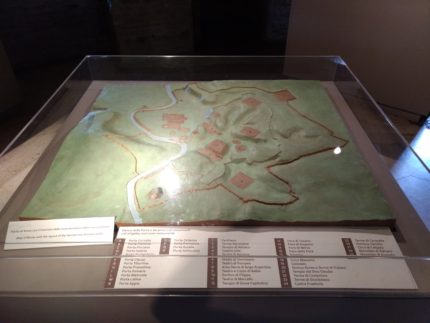
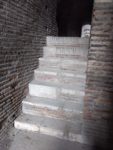 A few more details about the awesome wall walk. There are more stairs than you might expect leading up to and down from the towers, and they have pretty hefty rises. None of the information placards mentioned the steps, so they could date to Aurelian, Honorius or later alterations, or be a mixture. I bring them up because they very clearly employ recycled building materials, a practice that was done from ancient times all through to 20th century when laws against cannibalizing cultural patrimony were passed.
A few more details about the awesome wall walk. There are more stairs than you might expect leading up to and down from the towers, and they have pretty hefty rises. None of the information placards mentioned the steps, so they could date to Aurelian, Honorius or later alterations, or be a mixture. I bring them up because they very clearly employ recycled building materials, a practice that was done from ancient times all through to 20th century when laws against cannibalizing cultural patrimony were passed.
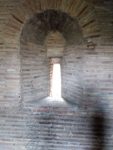 Here is an arrow slit just because I think arrow slits are cool, and this one is deep in an ancient wall therefore extra cool. The bow windows in the Porta Appia were modified as late as 1848 when they were made more rectangular to accommodate modern artillery, as you can see in this image. A pigeon gave me a brutal side-eye through one of those and it would have made such an awesome picture but the little bugger flew off before I could capture him.
Here is an arrow slit just because I think arrow slits are cool, and this one is deep in an ancient wall therefore extra cool. The bow windows in the Porta Appia were modified as late as 1848 when they were made more rectangular to accommodate modern artillery, as you can see in this image. A pigeon gave me a brutal side-eye through one of those and it would have made such an awesome picture but the little bugger flew off before I could capture him.
The third tower along the wall walk route is nifty for two reasons: it retains its original configuration from 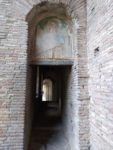 the modifications of Honorius (401-402 A.D.) and because a hermit is believed to have lived there in the Middle Ages. A fresco of the Virgin Mary and Child was painted on the exterior during that time. It was recently restored and still looks pretty bad, not unexpectedly so given its exposure to the elements for centuries and the budget nature of the original work.
the modifications of Honorius (401-402 A.D.) and because a hermit is believed to have lived there in the Middle Ages. A fresco of the Virgin Mary and Child was painted on the exterior during that time. It was recently restored and still looks pretty bad, not unexpectedly so given its exposure to the elements for centuries and the budget nature of the original work.
I mentioned in my bleary post yesterday that the interiors of the two massive flanking towers were cool. They are suffused with light, unlike the towers in the wall, and the west tower has a fascinating series of graffiti preserved and embedded in its new(ish) plaster walls. I assume these came from the outside of the gate which still has a bunch of medieval inscriptions carved into its marble, but there were no panels explaining them.


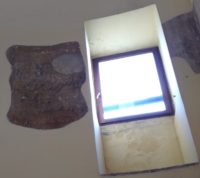
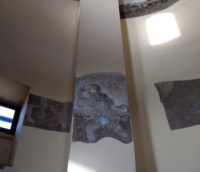
There you have it. A reasonably full account of my visit to the Museo delle Mura. Obviously I recommend it highly, and since the Appia Antica starts at its feet, it’s an excellent way to start off an excursion to the catacombs and many, many other important burial sites along Rome’s most trafficked ancient roadway.